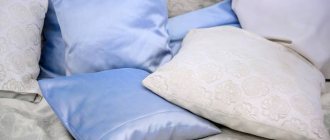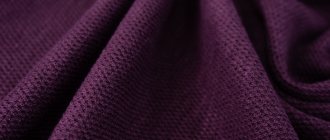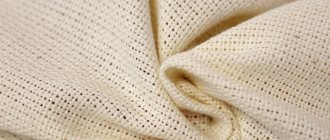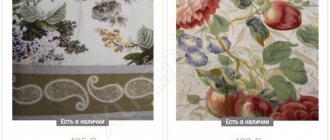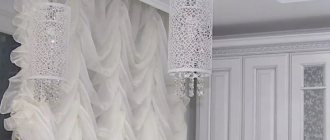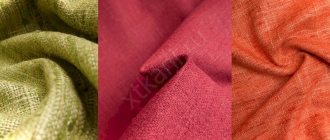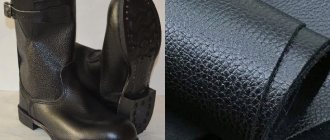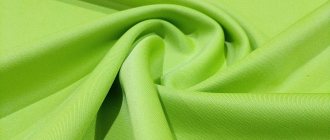Characteristics and composition of crepe-satin
Since 1960, crepe-satin fabric has been very popular. It began to be produced in China. At first, natural silk fiber was used for weaving, and since 1850, cotton threads began to be used in factories. Today, raw materials can contain both natural and artificial fibers. Crepe-satin fabric is characterized as a double-sided fabric with a smooth, glossy texture on the front side and a matte, grainy texture on the reverse side. In it, each side can become the front of the product. The high price of natural linen does not allow many consumers to purchase products made from it.
Fabric range
Therefore, to make the cost of fabric affordable for the average buyer, manufacturers have developed technology with the addition of synthetic fiber:
- acetate silk;
- synthetic polyester;
- cellulose;
- viscose.
The price of 1 meter of good material should not be less than 250 rubles. If a retail chain offers fabric at a reduced price, this indicates that they are buying a fake. The fabric is sold in a roll, the width of which is 150 cm.
Factory delivery of matter to the retail chain
Manufacturing methods and composition
The crepe effect is the grainy structure of the fabric and roughness to the touch, achieved by several production methods:
- Using crepe twist threads. They have up to three thousand twists per meter of length, as a result of which they become highly durable, elastic and dense. In this case, most often, a plain weave of fabric is used, in which the threads twisted to the right and to the left alternate separately. With this method, one of the final stages is boiling, due to which the threads partially unevenly unwind, creating a crepe effect on the surface.
- Use of finely patterned weave. Typically consisting of combinations of two or more different plexuses. As a result, the fabric structure has randomly scattered elongated main overlaps. In such paintings the pattern is never repeated.
The first crepe fabrics were made exclusively from silk fiber, but as the textile industry developed, their composition changed. Today the following raw materials are used:
- natural: silk;
- cotton;
- wool;
- artificial and synthetic: acrylic;
Basic properties of fabric
What kind of fabric is crepe-satin? Matter can be classified as a universal type of fabric. In double-sided fabric, the front and back sides are used for sewing. Combined products made from it have a special look.
The material has a glossy surface
Positive characteristics of crepe-satin fabric:
- Hygroscopic. The fabric absorbs and removes moisture well.
- Low creasing, drapes well.
- Wear-resistant. The product can withstand 200-250 washing cycles and retains its original appearance.
All properties correspond to the material
. In addition, the properties of the fabric allow it to keep its shape for a long time, not fade or fade.
In addition to its advantages, the material also has disadvantages:
- during cutting and sewing, the fabric can fray;
- does not allow air to pass through well;
- In the summer, it is advisable to wear dresses with a non-tight silhouette.
For your information! In case of irritation from the smoothness of bed linen, it is better to use cotton pajamas for a night's sleep.
Flaws
- Flowability, which complicates cutting and sewing.
- The material is difficult to work with because it slides and warps.
- It does not allow air to pass through and does not allow the body to breathe, which leads to sweating and sometimes irritation of the skin.
- Tendency to form snags if not handled carefully.
- Like all synthetics, they accumulate static electricity.
Production
Initially, manufacturers used only natural silk fibers to produce fabric. Expensive raw materials have been replaced by synthetic and semi-synthetic fiber. To produce the material, diagonal fiber twisting technology is used. Thick and thin threads are involved in the interweaving of warp and weft threads. They twist alternately to the right and then to the left. This makes the fabric elastic and durable. At the end of the technological process, the fabric must be steamed. After exposure to water and high temperatures, uneven unwinding of the threads occurs, which leads to the formation of crepe. The result is a fabric with a grainy texture.
You might be interested in what you can sew from kulirka: composition and features of the fabric
Additional Information! In addition to silk with a crepe weave of fibers, manufacturers produce crepes from cotton, wool, wool blend, artificial and synthetic threads. A simple finely patterned weave of fibers only creates the effect of strength.
Description
Crepe satin combines rich appearance, cheapness and functionality. Silk fabric is a type of crepe material.
Crepe satin is a double-sided material, which is why it differs from other fabrics. The outer one is shiny and glossy, and the inner one is matte with a grainy texture. The front side in appearance resembles satin and silk, and the back side resembles crepe fabric. It is worth noting that either side is used as the front side, and the other is used for finishing.
The material combines the qualities of crepe and satin. The fabric is wrinkle-resistant. It is not subject to deformation during operation.
The fabric is dense and durable, almost not translucent and does not stretch. Thanks to its elastic properties, it drapes well, which expands the possibilities for sewing festive outfits and evening dresses.
Strengths and weaknesses of the canvas
Despite the fact that the fabric has some disadvantages, it is very popular. Plain-dyed and printed fabric produces bright, interesting products.
Masters find alternative solutions to solve problems:
- While cutting and sewing things, the sections begin to crumble. To avoid this, tailors use some methods: gluing the sections with non-woven material or laying a temporary overlay.
Non-woven fabric for processing cuts
- The fabric structure is dense, so it can cause irritation or sweating. To feel comfortable in a dress, you need to allow for a loose fit. In this case, the air flow for the body will create comfortable conditions.
Method of processing a cut with non-woven fabric
The material looks very similar to satin or silk. It produces easily draped products that practically do not wrinkle in the finished product. The fabric is used not only for sewing clothes, but also for textile products for interior decoration of residential and office premises. The structure of the fabric has a dust-repellent effect.
Description and composition
Crepe-satin is a fabric of high-density weaving threads, although it is similar to satin, it differs in quality.
- Refers to silk fabrics, but the addition of synthetic threads is allowed. Expensive fabric uses natural silk; Available varieties include viscose, polyester (polyester), and silk acetate. Additives do not impair the consumer quality of the fabric; it retains high strength and beauty.
- The fabric, thanks to its finely patterned weaving, is elastic and dense. The shine depends on the properties of the thread: the more twisted it is, the stronger the shine.
Advantages
Matter is valued because of its obvious advantages:
- Practicality . The products are soft, durable and wear-resistant at the same time. The dense weave of the threads makes it difficult for dirt to get wet and penetrate.
- Versatility . Wide range of applications, including clothing, interior decor, bed linen.
- Comfort of use . The material is pleasant to the touch, does not slip and wrinkles slightly.
- Design possibilities . Double-sided fabric with a draping effect opens up a wide field for experimentation.
Flaws
A description of the fabric would not be complete without mentioning the disadvantages:
- Difficulties at work. The fabric is tricky when cutting and sewing - it slips and crumbles along the edges.
- The material is susceptible to snags.
- Mixed varieties (with the addition of synthetics) tend to accumulate electricity. Products made from mixed fabrics are less permeable to air and moisture and sometimes irritate the skin.
Fabric selection criteria
Today, natural silk is rare due to its high cost. Therefore, products made from synthetic fibers are mainly sold in the retail chain. Before purchasing fabric, you need to pay attention to some of its features:
- Due to its dense structure, high-quality fabric is not see-through.
- The price of natural silk should not be low. Good quality rayon is also in the price range, it should not be low.
- The presence of a strong chemical odor indicates that the material contains aggressive substances. Dyes may cause an allergic reaction or skin irritation.
For your information! The combination of two sides of crepe allows you to get beautiful spring suits, dresses, skirts and other products. The fabric combines beautifully. Its front side has a glossy appearance, while the back side is slightly rough.
What can you sew from this fabric?
The beautiful fabric with a satin sheen gives the products a special charm. And any interior made from this fabric will be decorated with curtains with lambrequins, bedspreads with ruffles or decorative pillows. What can you sew from crepe satin?
You might be interested in Description of French knitwear: what is tricotine
Bridesmaid Dresses
- Evening dresses. An evening suit made of yellow silk, sewn on the reverse side with elements of shiny trim, will turn out to be sophisticated. The fabric is also used for sewing wedding dresses.
Evening Dress
- Bed dress. Textile products do not wrinkle, practically do not get dirty, and retain their aesthetic appearance for a long time. The linen is pleasant to the body and creates a soothing coolness.
Wedding outfit
- Beautiful clothes for the bedroom - pajamas, peignoir, nightgown, as well as bedspreads and pillowcases.
Bed sheets
- Curtains. The material drapes well. It is used for sewing curtains, curtains, and theater backstage.
Pillowcases
In addition, office blouses, summer skirts, women's trousers, New Year's suits and other items are made from silk.
For your information! Even though silk is durable, it must be treated with care. If handled carelessly, snags may appear.
Curtains
Application area
The main use of the material is sewing modern elegant clothes. For example, today dresses, tops, skirts, and blouses made of crepe-satin trimmed with lace are very fashionable and popular. The products look stylish, modern and beautiful. Floor-length styles of skirts and dresses are popular and in demand, as well as short flared or tapered “pencils,” and various models for plus-size ladies.
Particular attention should be paid to wedding dresses. They can be different: long and short, fluffy and tight-fitting, light and heavy. But especially fashionable are red or black dresses created by bold designers especially for brides. They make the image extraordinary.
The described fabrics are used to make spectacular suits, trousers, elegant boleros, even authentic gypsy skirts, including for stage outfits. Such details emphasize the individuality of the owners. You can also purchase unusual home models: bathrobes, pajamas, aprons.
However, carefully study the composition of the fabrics: they must be 100% natural!
The same goes for crepe-satin bed linen. If you buy a blend or, especially, a synthetic one, you may be very disappointed in the purchase.
Crepe-satin is used to create home textiles: tablecloths, curtains, bedspreads, curtains. They also decorate lambrequins.
In addition to the above, manufacturers offer beautiful ribbons, bows, headbands and other women's accessories made of crepe-satin.
Tricks for sewing from crepe-satin
During sewing or use of a garment, the fabric may show its shortcomings. Each craftswoman has her own various tricks developed over a long period:
- To prevent the fabric from fraying, the cut can be treated with PVA glue, scorched with a lighter, or applied with nail polish. The glue does not leave marks on the pattern.
- Use sharp needles No. 70-80. Rounded knitting needles will damage the fiber structure of the fabric, resulting in an unsightly pulled seam.
- To make the edge of the part beautiful, you need to place it between two even sheets of glass and singe the cuts.
- During cutting, you can use hot scissors or a soldering iron for creative work. You need to attach a metal ruler to the sections of the part and draw them with a soldering iron.
- To prevent the fabric from fraying, you must first sew it with an oblique or looped seam. After completing the fittings, process the seams with an overlocker.
To avoid warping of the product during cutting, you need to stabilize the fabric. It should lie flat on the table and not move. To do this, you can spray it with hairspray or soak it in a weak solution of gelatin - dilute 3 teaspoons of gelatin in 200 g of water. Leave for 10-15 minutes. Bring to a boil and dilute in 3 liters of warm water.
For your information! Wet the fabric, dry it, iron it and start cutting.
You might be interested in How to check the naturalness of silk: the best proven methods
Care
Caring for things made of crepe-satin is not difficult. There is practically no need to iron them, and if such a need does arise, then only from the inside out and while the fabric is still damp. Gentle mode for silk.
Many housewives are interested in the question of how to wash this beautiful fabric. The best option is manually, without aggressive detergents, at a temperature not exceeding 40°C. Squeeze carefully. The material, although durable, does form puffs or snags. In general, we advise you to carefully study the accompanying label, which indicates how to properly wash and iron your crepe satin.
Another common question is: how to process fabric? Experienced craftswomen recommend rubbing the machine needle with soap - this will make sewing easier. Use tracing paper to make the process easier. Well, if you don’t know how to starch a thing, then the easiest way is: one and a half teaspoons per liter of water, soak the product for 10-15 minutes. You can use household chemicals (Domol, Sano Ironing Starch, Luxus).
In general, crepe-satin is a unique, beautiful material that, if used correctly, will last for many years, maintaining a chic appearance.
Dear readers of the Tkan.Club website, if you still have questions on this topic, we will be happy to answer them. Leave your reviews, comments, share stories if you have dealt with this material! Your life experience may be useful to other readers.
Caring for things
Sewing products and accessories made from crepe-satin fabric do not require complex care. The aesthetic appearance will remain for a long time if you adhere to certain requirements:
- For hand washing, use only warm water (30-35 ⁰C). Washing in hot water may cause the product to “weld”.
- To preserve color, use vinegar (150-200 ml per 10 liters of water) or fabric conditioner.
- Iron only from the wrong side, without waiting for complete drying, and without steam.
- Do not allow drops of water to come into contact with the fabric. This will wash the entire item.
Iron the product from the wrong side without steam.
The described rules apply to those who turn to a tailor for work. But today there is a label on factory products. It indicates all the requirements for caring for the product.
Crepe-satin fabric - first acquaintance
This is silk fabric, a type of crepe. Belongs to a group of fabrics that are made from threads with high twist. This twist is called crepe twist.
Satin is a weaving method in which two threads are used - dense for the base and thin on the front side. Natural crepe-satin is based on raw silk and raw silk crepe in the weft. On the front side the material is very smooth and shiny, but on the other side it is matte, grainy and rough to the touch.
Outwardly similar to satin, but may differ in composition.
Reviews
Ksenia, 42 years old: “As a tailor, I know all the intricacies of working with this capricious silk. To make garments from crepe-satin fabric, I use silk, viscose or cotton threads. Polyester threads tighten the fabric. To prevent this from happening, you need to use tracing paper. When sewing, the paper needs to be placed at the top and bottom where the stitching will go.”
Assortment of threads used for sewing products
Yana, 27 years old: “We have bed linen. This was a wedding gift from guests 3 years ago. I try to use it during the warm season. During this time, it has not changed color, it is pleasant to rest on it, and in the summer it brings coolness to the body.”
Lilia, 34 years old: “I have an evening dress, but it is very tight on my figure. I feel a little uncomfortable in it, so I advise all fashionistas to buy products that do not fit their figure.”
One of the popular types of fabric
Crepe-satin fabric will be in demand for a long time not only among fashion designers, but also among consumers. The presence of outfits in the wardrobes of fashionistas indicates that she has more positive qualities than negative ones.
Properties of crepe-satin
Crepe satin is considered a double-sided fabric; when sewing products from it, you can use both the front and back sides, it all depends on the effect you want to get. Has many positive qualities:
- creases little;
- easy to iron;
- very wear-resistant;
- soft;
- drapes easily and forms beautiful folds;
- dries quickly;
- does not slip;
- practically does not fade, holds paint well;
- has dust-repellent properties.
Flaws:
- crumbles when cutting;
- clues are formed;
- if it is based on synthetics, it can cause allergies upon contact with the skin, as well as increased sweating, as it does not “breathe” well.
